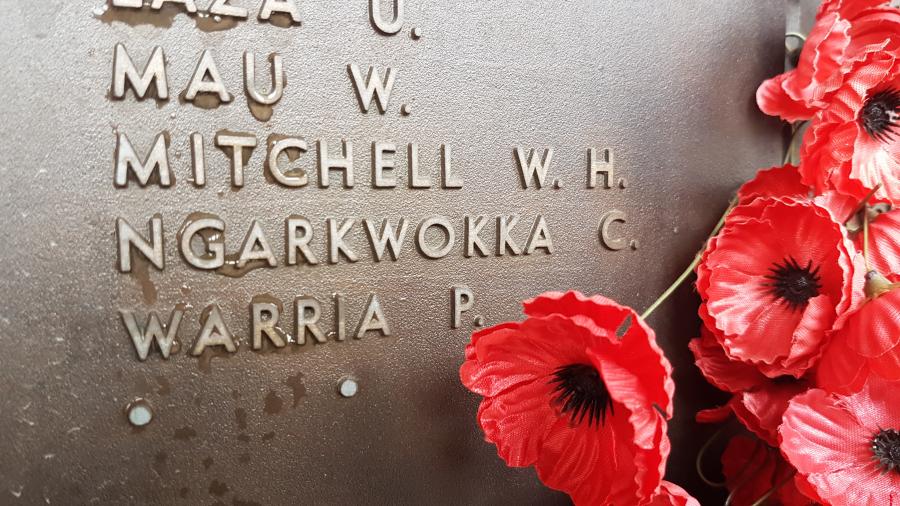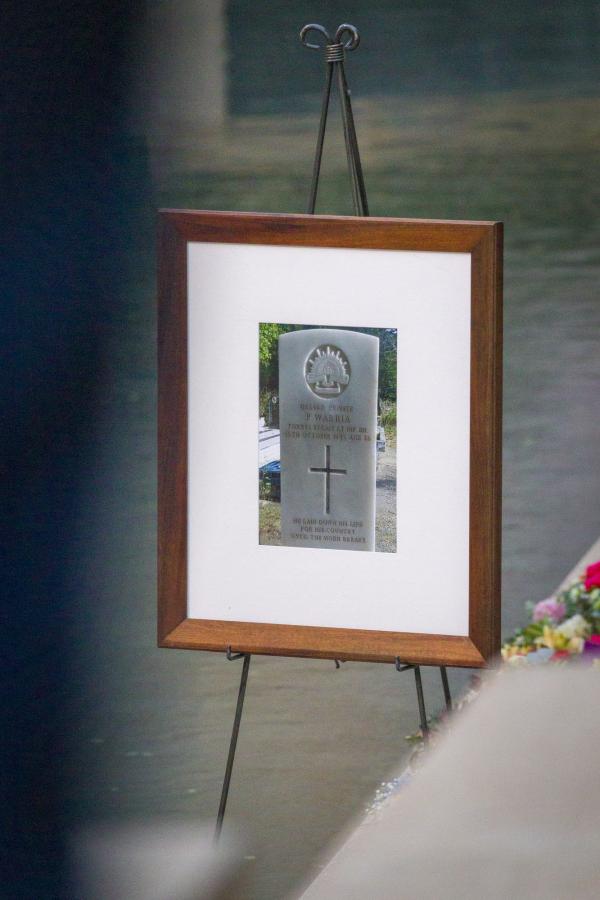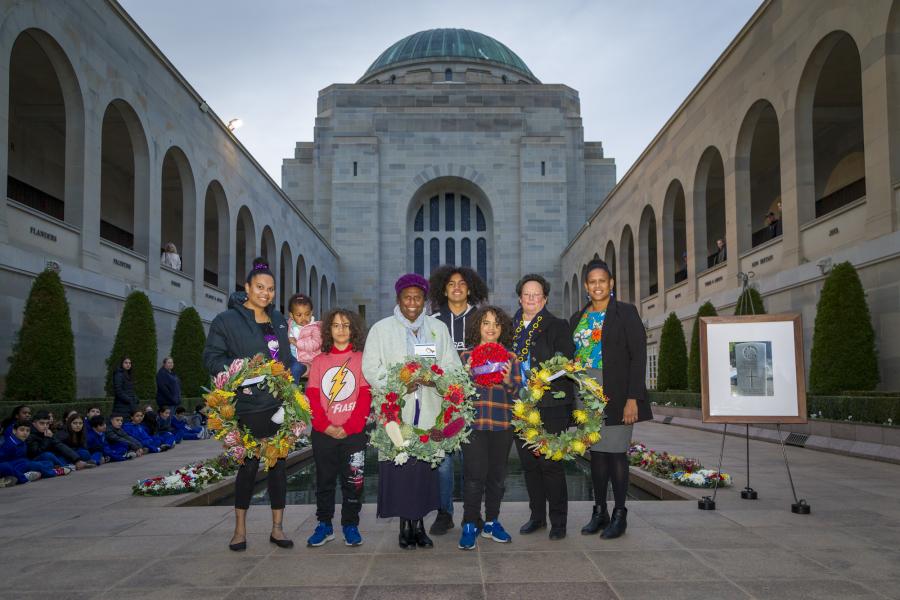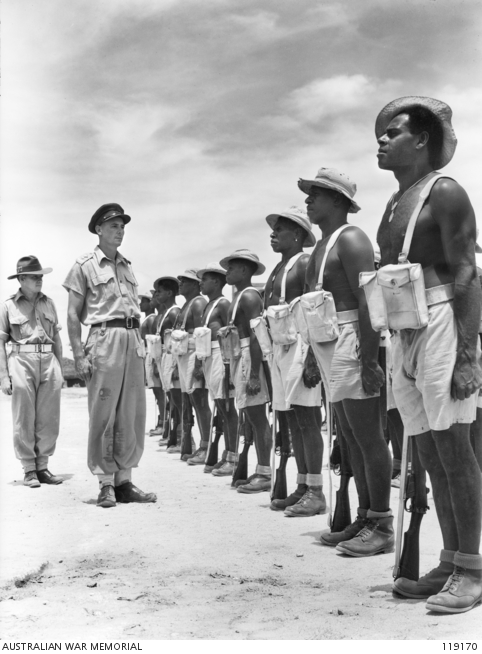Peniatha Warria: Defending his island home
Warning: Aboriginal and Torres Strait Islander people please be advised that the following article contains the names and images of deceased people.

During the Second World War, almost every able-bodied man in the Torres Straits signed up to defend their country against the threat of invasion.
Among them was Private Peniatha Warria, a 23-year-old Kulkalgal man who volunteered to defend his island home.
His life was commemorated in a Last Post Ceremony at the Australian War Memorial.
Kerryn Ah Chee, the Indigenous Research Officer at the Memorial, laid a wreath in his honour.
A proud Kulkalgal woman from Masig (Yorke) Island in the Central Islands of the Torres Straits (Zenadth Kes), Kerryn has been working with the Memorial’s Indigenous Liaison Officer, Michael Bell, to help identify Torres Strait Islander men and women who have served or are still serving.
Private Peniatha Warria’s story is close to her heart.
Peniatha Warria was born on her home island of Masig on 1 November 1919, the youngest of three children born to Wabu Warria and Mesepa Borioe.
Like many other men on the island, Peniatha was working as a seaman when the Second World War broke out. Seamen were renowned for their navigation skills and knowledge of the Torres Straits, often working in the commercial fishing and pearling industries.
From the early days of the war, the possibility of conflict in the Pacific posed a major problem for Australia’s regional security.
To protect Australia’s northern interests, an independent company of men was established in May 1941 to defend the Torres Strait Islands.
It would later become known as the Torres Strait Light Infantry Battalion, Australia's first and only all-Indigenous army unit.
Many local men immediately volunteered, and the battalion quickly gained hundreds of recruits.
When Japan entered the war in December 1941, it brought the threat to Australia’s doorstep. The situation in the Pacific deteriorated rapidly throughout 1942 as Japanese forces swept through the region and island nations began to fall.
As the threat increased, more Torres Strait men volunteered.
Peniatha was one of them, enlisting on 25 October 1942 alongside his older brother, Langley. They were assigned to A Company, which consisted of men from the Central and Eastern Islands, and were quickly trained for their new defensive role.
By late 1942, so many Torres Strait men had enlisted that the unit was able expand to a battalion.
Over the course of the war, almost every eligible Torres Strait man would enlist for service in the local battalion. Their knowledge of the Torres Strait and its waters would prove invaluable to the Allied war effort in the region.
One intelligence report noted: “The Islanders are a fit, strong looking lot of men. They look fine and savage in uniform. They are keen as mustard and can give us lessons in drilling and marching. I would rather fight with them than against them.”
The men served on the islands of the Torres Strait alongside thousands of other Allied servicemen, with companies spread across the Torres Strait on Horn Island, Goode Island, Yorke Island and Thursday Island.
They were instrumental in the defence of vital infrastructure, such as airfields on the islands, and were heavily involved in activities to increase the region’s security. These activities included digging trenches, constructing defensive posts, and sandbagging, as well as guard duties, reconnaissance and continued tactical training exercises.
During this time, the battalion often suffered from outbreaks of illness and disease, a result of personnel serving closely together.
Peniatha became ill in June 1943, showing signs of respiratory problems. He was transferred to Thursday Island for treatment at the 6th Australian Camp Hospital, where it was discovered that he had contracted tuberculosis. He remained in hospital for several months, but his condition gradually worsened, and he succumbed to the disease on 16 October 1943.
The men of the Torres Strait Light Infantry Battalion would go on to serve in parts of New Guinea, as well as the continuing defence of the Torres Strait, earning a reputation as brave and fearsome soldiers. They were also responsible for championing pay equality for First Nations Peoples who served during the war. The members of the battalion had originally received only one-third the pay of white soldiers of equal rank. In response, some went on strike in December 1943; the army agreed to increase their pay to two-thirds that of white soldiers a few months later. They received full back pay for their wartime service in 1986.
Following his death, Peniatha’s remains were returned to his home island. Today, he lies at Yorke Island Cemetery, beneath the inscription chosen by his family: “He laid down his life for his country. Until the morn breaks.”

For Kerryn, his story is particularly special.
“He was so young,” Kerryn said.
“He didn’t have a wife, or any children, but he did have a brother, who joined the Torres Strait Light Infantry Battalion as well, and a sister.
“Langley spoke very little of his brother after the war, so there isn’t really much information about Peniatha and what he was really like.
“He joined up when he was quite young, but it looks as though he actually lied about his age. He said he was 25 when he enlisted, but he would have been only about 23.
“It’s interesting he did that because he was old enough to join, but I guess he wanted to make out he was older than he was.
“As a Torres Strait Islander woman, just being able to share the story of what he did at such a young age is really important to me.
“It’s about recognition that there was a Masig man from the Kulkalgal nation in the Torres Strait, the Zenadath Kes, who served in the Torres Strait Light Infantry Battalion for his people.”
She hopes sharing his story will encourage other families to come forward with stories of their own.
“It’s really important to tell these stories,” Kerryn said.
“It’s about providing recognition for Torres Strait Islander men and women and for the battalion as well.
“Most of the men joined because they saw it as their duty to defend their island homes, but they wanted to stand with Australia as well.
“But there might be other families wanting to come forward, wanting to share that their great-grandfather or their big athe served in the Torres Strait Light Infantry Battalion …
“Peniatha Warria wasn’t just doing it for himself; he was doing it for his people, and for his island home.
“He was a Kulkalgal man from the Central Islands and from Masig, so his story is very close to my heart.
“I really want to share his story for my island home and to make my island home proud.”

Michael Bell is the Indigenous Liaison Officer at the Memorial. He is working to identify and research the extent of the contribution and service of people of Aboriginal and Torres Strait Islander descent who have served, who are currently serving, or who have any military experience and/or have contributed to the war effort. He is interested in further details of the military history of all of these people and their families. He can be contacted at Michael.Bell@awm.gov.au
The Torres Strait Islands include: The Western Islands known as Malulgal Nation - Badu (Mulgrave Island), Mabuiag (Jervis Island), Arkai (Kubin Island), Moa Island (St Pauls Island); The Top Western Islands known as Gudaw Maluligal Nation – Saibai (Saibai) Island, Boigu (Talbot Island), Dauan (Mt Cornwallis Island); the Central Islands known as Kulkalgal Nation – Iama (Yam Island), Masig (Yorke Island), Warraber (Sue Island) and Poruma (Coconut Island); the Eastern Islands known as Kemer Kemer Meriam Nation – Mer (Murry Island), Erub (Darnley Island), and Ugar (Stephen or Stephens Island); Kaiwalagal Kaurareg Aboriginal Nation – Kirriri (Hammod Island); as well as Thursday Island (Waiben), Horn Island, Prince of Wales Island, and Friday Island.
There are also five Aboriginal and Torres Strait Islander communities – Bamaga, Seisia, Injinoo, Umagico and New Mapoon – located in the Northern Peninsula Area of Cape York.

